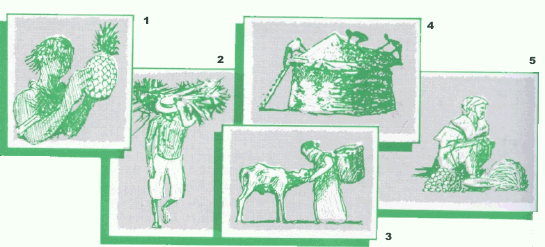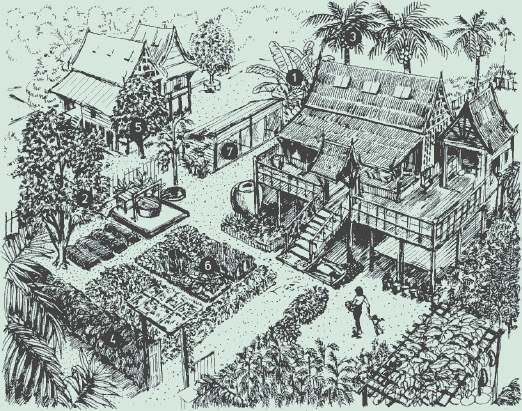


In non-industrial regions, trees are inextricably woven into the rural and household economies. They are used to provide fuel, fodder and food. They supply medicines and shade, increased soil fertility, shelter from the wind and protection from the rain. From them women fashion many of the products used in the house- and, often enough, the house itself. Perhaps most importantly of all, trees and forests provide many rural women with their only source of personal income.

trees can provide five essential elements in the household economy:
1. food
2. fuel
3. fodder
4. products for the home; and
5. income
The home gardens of south-east Asia provide the most vivid illustration of the importance of trees in providing family food. Within perhaps 50 metres of each dwelling can be found bananas, coconuts, sugar apples, mangos, star apples, guavas, avocados, and bread fruit. In Indonesia, no less than 37 species of fruit trees have been found growing in just one home garden. Even in societies in the Middle East, many women plant fruit trees within their walls.
Fruit is part of the regular diet of most people. But trees provide many other forms of nutrition. Nuts- high in both calories and protein- are an obvious example. Cashew nuts, in particular, are highly prized in many African countries. And in the Kalahari, the staple food of the Bushmen comes from the mongongo tree (Ricinodendron digitata), which provides both a fruit and a nut. The nut is roasted and, if necessary, stored.
The leaves, seeds, pods, sap and bark of trees form part of the diet of many rural people. The leaves of the baobab, rich in vitamins, are a major ingredient of the sauces served with starchy foods in some African countries. The vitamin-rich fruit from the same tree is known as monkey bread. The seeds from locust trees (Parkia species) are cooked like beans, or fermented and added to sauces. This food, more than that: they are often the only reliable source of food for the family when crops fail or during the lean periods between harvests. In Tanzania, two or three tree species are enough to provide some food for every month of the year. Research has shown that these trees are used more intensively during famines or droughts, illustrating their important role in providing food security.
Furthermore, once established, trees need little care, and the food they provide often requires no effort other than picking or collecting. Much of the food that trees produce can also be stored without further processing.

typical home garden in southeast Asia
1. bananas
2. mangos
3. coconuts
4. living fence
5. shade trees
6. vegetable garden
7. poultry
Trees can provide produce at times of the year when annual crops never can, simply because their deep roots give them access to moisture throughout the year. The mango, for example, provides its fruit at the beginning of the rainy reason, when other crops are just being planted and the harvest is still distant. In the Sahel, pressure of work during planting can be so intense that there is not enough time to cook, and many families rely for nourishment on mango fruit which grow in the fields themselves.
The importance of the food obtained from trees is reflected in the laws and customs of many societies. Women, for example, often have the right to utilize breadfruit in the Pacific area even though the tree itself is the province of men, who use it as a source of wood for furniture and canoes. In Nigeria, women may have rights to the kernel but not to the oil of the palm which is often sold as a cash crop.

trees and forests provide many different forms of food:
a. fruit
b. nuts
c. pods
d. leaves
e. bark/sap
f. honey
g. fungi
Because women are aware of the utility of trees on the homestead, they take good care to plant and maintain them. In many if not most rural societies, it is only the women who have accumulated the traditional knowledge about the foods and other household products that trees can supply. A survey in Sierra Leone has revealed, for example, that women could name 31 products that they gathered or made from the nearby bush while men named only 8.